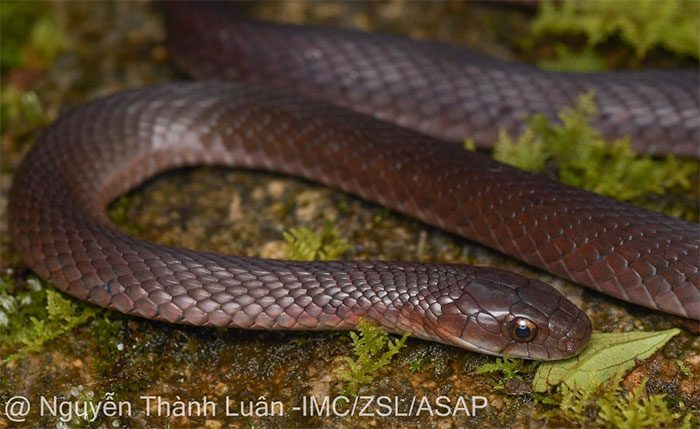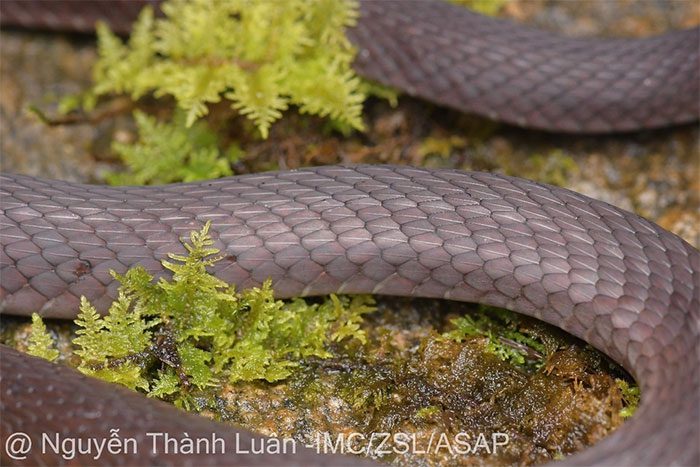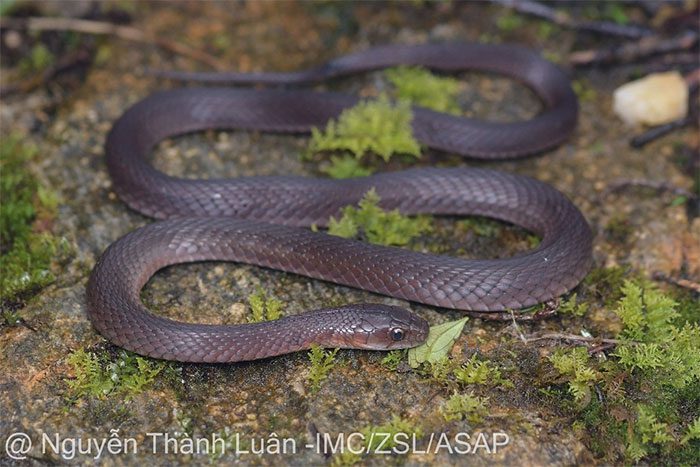A new species of snake has been discovered by international and Vietnamese scientists at an altitude of 2,600 meters on the summit of Fansipan Mountain (Sa Pa), within the Hoàng Liên National Park of Lào Cai Province.
According to Hoàng Liên National Park, in September 2023, a new species of snake was officially identified in the high mountainous region of Hoàng Liên in Sa Pa, based on a specimen of an adult male.

Close-up image of the head of the H’mong keelback snake. (Photo: Hoàng Liên National Park).
This new reptile species is scientifically named: Rhabdophis hmongorum Kane, Tapley, La and Nguyen, 2023, with the English name: H’mong keelback snake and its Vietnamese name: Rắn hoa cỏ H’mông.
This is the 32nd species in the genus Rhabdophis worldwide and the 9th species identified in Vietnam.
The species name honors the H’mong ethnic group, to appreciate the H’mong guides who accompanied the authors during the conservation project for amphibians at Fansipan from 2017 to present.
This discovery is the result of collaboration between the Hoàng Liên Rescue, Conservation, and Development Center (under Hoàng Liên National Park), the London Zoological Society, the Indo-Myanmar Conservation Organization, and the National Museum of Australia, aimed at researching and conserving amphibians and reptiles in the Hoàng Liên Mountain Range from 2022 to 2027.
Some identifying characteristics of this new species are as follows: The body is cylindrical, with a body length of 409 mm from the snout to the vent, a tail length of 106 mm, and has 17 rows of scales around the body near the neck, 17 rows in the middle of the body, and 15 rows around the body near the vent.

Image of the dorsal scales of the H’mong keelback snake. (Photo: Hoàng Liên National Park).
The snake has 151 rows of belly scales and 59 divided rows of scales under the tail; dorsal scales have keels with 5 well-developed rows along the back. The snake’s mouth contains 25 fang-like teeth, with the two innermost teeth being the most developed and longest. The entire body is gray-pink, with black eyes featuring bronze pupils on top, and a gray-white chin. The belly has shiny light brown scales.
This new snake species can be distinguished from others in the same genus by the number of upper jaw teeth, scale characteristics on the body, and genetic differences of about 4% in a segment of the mitochondrial DNA sequence (cytb).
A specimen collected from the Honghe area in Yunnan Province, China, has had its genetic sequence published in the GeneBank, matching the specimen described in this article.

Image of the H’mong keelback snake, a new species published in Zootaxa, issue 5343 (2) on September 7. (Photo: Hoàng Liên National Park).
This indicates that the distribution of the new snake species is not limited to Vietnam, but extends to China as well.
Further studies are needed to understand the distribution, natural history, and biological characteristics of this species.
The results highlight the need for continued research on the diversity of reptile species in Hoàng Liên National Park, as well as in the Hoàng Liên Sơn mountain range, and to enhance collaboration between Hoàng Liên National Park and domestic and international agencies in the research and conservation of wildlife.
Images of the H’mong keelback snake have been published in the zoological classification journal Zootaxa, issue 5343 (2) on September 7.


















































